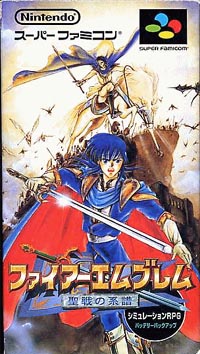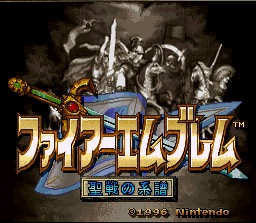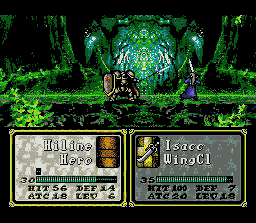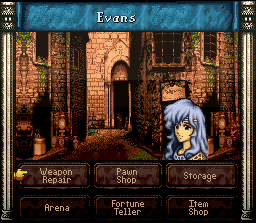
Title: Fire Emblem: Seisen no Keifu
English Name: Fire Emblem: Genealogy of the Holy War
Main Characters: Sigurd and Selis
Release Date: May 15th, 1996
Introduction
Part 1: Intelligent Systems
Part 2: Dark Dragon and Sword of Light
Part 3: Fire Emblem Gaiden
Part 4: Mystery of the Emblem
Part 5: Genealogy of the Holy War
Part 6: Thracia 776
Part 7: Sword of Seals
Part 8: Blazing Sword
Part 9: Fire Emblem Tradition
Part 10: BS, The Anime, The Card Game, and the Future
Originally written for
in January 2004
by Derek Miller


Super Nintendo was home to some of the most popular games in many popular game series. Donkey Kong Country, Final Fantasy 6, Chrono Trigger, Super Metroid, and The Legend of Zelda: A Link to the Past are widely believed to be the best games in their respective series. The fourth Fire Emblem game, Fire Emblem: Seisen no Keifu, is pretty much unanimously believed to be the best game in the Fire Emblem series. It would also be the last game in the series that Gunpei Yokoi worked on. Seisen no Keifu, or Genealogy of the Holy War, was released in Japan on May 15th, 1996 keeping Nintendo's pattern of releasing a Fire Emblem game every two years. I would like to say something different other than the game sold incredibly well, but every game in the Fire Emblem series sold well in Japan and Genealogy of the Holy War was no different.
 The first three Fire Emblems took place in the same world, but Genealogy moved away from the continents of Akanea and Valencia. The game takes place on the continent of Jugdral, and focuses on the kingdom of Grandbell. The kingdom was founded by Heim the Saint, one of the twelve ancient Holy Warriors, and is always ruled by a descendant of Heim. Currently King Azmule rules the kingdom, but his frail, old age has forced Prince Kult to manage many of the kingdom's affairs. The kingdom is divided into six different areas, each run by a descendant of one of the Holy Warriors, and each area is totally self-contained with its own armies. However, Father Claude of the House of Edda becomes concerned when Prince Kult asks Lord Ling of the House of Jungvi to assist Kult in governing the kingdom. This in itself does not concern Father Claude, but when Lord Leptor of the House of Freege expresses his displeasure in the move Claude becomes worried. Lord Leptor, as Prime Minister of Grandbell, feels his position is being undermined so he allies with Lord Rangobalt of the House of Dozel. Things really start to go wrong when barbarians from the Isaac Kingdom invade the town of Darna and many innocent people are slaughtered. The people of Grandbell demand retribution so Prince Kult, along with his trusted warrior Lord Byron of the House of Chalphy, leads the army of Grandbell against Isaac. With the Prince and the army gone, Grandbell is left in a weakened state.
The first three Fire Emblems took place in the same world, but Genealogy moved away from the continents of Akanea and Valencia. The game takes place on the continent of Jugdral, and focuses on the kingdom of Grandbell. The kingdom was founded by Heim the Saint, one of the twelve ancient Holy Warriors, and is always ruled by a descendant of Heim. Currently King Azmule rules the kingdom, but his frail, old age has forced Prince Kult to manage many of the kingdom's affairs. The kingdom is divided into six different areas, each run by a descendant of one of the Holy Warriors, and each area is totally self-contained with its own armies. However, Father Claude of the House of Edda becomes concerned when Prince Kult asks Lord Ling of the House of Jungvi to assist Kult in governing the kingdom. This in itself does not concern Father Claude, but when Lord Leptor of the House of Freege expresses his displeasure in the move Claude becomes worried. Lord Leptor, as Prime Minister of Grandbell, feels his position is being undermined so he allies with Lord Rangobalt of the House of Dozel. Things really start to go wrong when barbarians from the Isaac Kingdom invade the town of Darna and many innocent people are slaughtered. The people of Grandbell demand retribution so Prince Kult, along with his trusted warrior Lord Byron of the House of Chalphy, leads the army of Grandbell against Isaac. With the Prince and the army gone, Grandbell is left in a weakened state.
Prince Kult did not worry about Grandbell's defenses because the two countries that border the kingdom, Agustria and Verdane are both allies of Grandbell. Unbeknownst to Prince Kult, however, is that Verdane has always resented Grandbell, and Prince Gandolf of Verdane uses the opportunity presented before him to invade Grandbell and surround the castle of Jungvi where only Lord Ling's daughter Edin remains. Lord Byron's son, Sigurd, is a childhood friend of Edin, and he vows to prevent the Verdane army from harming her. With this he sets off to Jungvi and the game begins. Halfway through the game the story will continue with Sigurd's son, Selis, and the descendants of many of the veterans from the first half of the game. Genealogy's story may not sound all that unique, but there are so many incredible plot twists in the game that many consider it to be one of the best stories ever in a videogame. It would be a disservice to spoil any of it here.
 Genealogy's gameplay changed in many ways when compared to previous Fire Emblems. Although the game only contains twelve chapters they are all incredibly long chapters. Instead of a single castle gate or throne to take over there are multiple castles spread across the map. Most of the castles contain a boss you must defeat in order to control the castle where you can heal your troops. In addition to taking over the castles you must protect your own castle where your army begins the chapter. Although protecting your own castle wasn't a unique idea to strategy/RPGs having multiple castles in the battlefield was unique, and both new features provided a lot more strategy to the game. Personal skills were a much-enjoyed part of Genealogy as each character in the first half of the game had a unique personal skill such as critical attacks when they were low on HP or the ability to attack five times in a row.
Genealogy's gameplay changed in many ways when compared to previous Fire Emblems. Although the game only contains twelve chapters they are all incredibly long chapters. Instead of a single castle gate or throne to take over there are multiple castles spread across the map. Most of the castles contain a boss you must defeat in order to control the castle where you can heal your troops. In addition to taking over the castles you must protect your own castle where your army begins the chapter. Although protecting your own castle wasn't a unique idea to strategy/RPGs having multiple castles in the battlefield was unique, and both new features provided a lot more strategy to the game. Personal skills were a much-enjoyed part of Genealogy as each character in the first half of the game had a unique personal skill such as critical attacks when they were low on HP or the ability to attack five times in a row.
 The incredibly innovative addition in Genealogy, and the reason it is beloved by fans of the Fire Emblem series, was the new love system. Since Genealogy took place over two generations it meant that sons and daughters of characters from the first part of the game would be in the second part of the game. The cool part is the control you are given over the kids. During the first generation when male and female characters are near each other in battle you can have them talk, which increases their affection for each other. If they talk enough they will get married, and their offspring will fight for you in the second half of the game as long as the mother survives the first half of the game. This can result in a wide range of sons and daughters, some better than others, and the son or daughter gains the personal skills and a combination of the stats growth of both of his or her parents. The sons and daughters of your warriors will also inherit any unique weapons that their parents used that you would lose otherwise. If you don't make some of your characters hook-up you will be given another character in the second half of the game who is usually a lot weaker than an offspring character would be. Of course, some characters in the first generation will have a greater affection for each other and will be easier to get together, but this does not necessarily mean they will produce the best kid. Sometimes the harder-to-start relationships produced the most powerful characters in the second generation. There would even be some cases of forbidden love with possible brother/sister love. Even the main villian Alvis ends up marrying his half-sister. This new feature gave the game incredible replay value, which the Fire Emblem series had lacked up until 1996, and completely rewrote the Fire Emblem series by introducing new ways to shop, the way critical attacks worked, and arena battles. The game also introduced the weapons triangle to the Fire Emblem series, which is now a staple of the series and should be well known to fans of the Fire Emblem game released in the United States.
The incredibly innovative addition in Genealogy, and the reason it is beloved by fans of the Fire Emblem series, was the new love system. Since Genealogy took place over two generations it meant that sons and daughters of characters from the first part of the game would be in the second part of the game. The cool part is the control you are given over the kids. During the first generation when male and female characters are near each other in battle you can have them talk, which increases their affection for each other. If they talk enough they will get married, and their offspring will fight for you in the second half of the game as long as the mother survives the first half of the game. This can result in a wide range of sons and daughters, some better than others, and the son or daughter gains the personal skills and a combination of the stats growth of both of his or her parents. The sons and daughters of your warriors will also inherit any unique weapons that their parents used that you would lose otherwise. If you don't make some of your characters hook-up you will be given another character in the second half of the game who is usually a lot weaker than an offspring character would be. Of course, some characters in the first generation will have a greater affection for each other and will be easier to get together, but this does not necessarily mean they will produce the best kid. Sometimes the harder-to-start relationships produced the most powerful characters in the second generation. There would even be some cases of forbidden love with possible brother/sister love. Even the main villian Alvis ends up marrying his half-sister. This new feature gave the game incredible replay value, which the Fire Emblem series had lacked up until 1996, and completely rewrote the Fire Emblem series by introducing new ways to shop, the way critical attacks worked, and arena battles. The game also introduced the weapons triangle to the Fire Emblem series, which is now a staple of the series and should be well known to fans of the Fire Emblem game released in the United States.
Fire Emblem: Genealogy of the Holy War remains a favorite of Fire Emblem fans, and a peek at the reviews at GameFAQs shows almost unanimous perfect scores. Intelligent Systems had to follow this game up with something spectacular, and they decided to do so by creating the most difficult Fire Emblem yet.